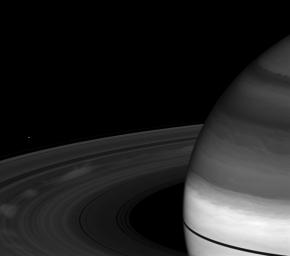Bright Spokes, Dark Rings
Caption:
Spokes, those ghostly radial markings on Saturn's B ring, appear bright compared to the rings in this image taken a little more than a month after the planet's August 2009 equinox.
Spokes appear bright when they are viewed at phase, or Sun-Saturn spacecraft, angles higher than about 45 degrees. The phase angle in this image is 64 degrees. Also, the contrast is even greater in this image since the surrounding rings are darkened during the equinox period at Saturn.
To learn more about spokes, see
PIA11144
.
Saturn's northern latitudes appear dark in this image because of the camera filter used. This view uses a spectral filter sensitive to absorption of certain wavelengths of light by methane in Saturn's atmosphere. In the north, the light at these wavelengths reaches slightly greater depth -- compared to the equatorial regions -- before being reflected off the cloud tops, and therefore passes through more light absorbing methane along the way out.
The novel illumination geometry that accompanies equinox lowers the sun's angle to the ringplane, significantly darkens the rings, and causes out-of-plane structures to look anomalously bright and cast shadows across the rings. These scenes are possible only during the few months before and after Saturn's equinox, which occurs only once in about 15 Earth years. Before and after equinox, Cassini's cameras have spotted not only the predictable shadows of some of Saturn's moons (see
PIA11657
), but also the shadows of newly revealed vertical structures in the rings themselves (see
PIA11665
).
The moon Janus (179 kilometers, or 111 miles across) is also visible on the left of the image.
This view looks toward the sunlit, northern side of the rings from about 12 degrees above the ringplane.
The image was taken with the Cassini spacecraft wide-angle camera on Sept. 22, 2009 using a spectral filter sensitive to wavelengths of near-infrared light centered at 890 nanometers. The view was acquired at a distance of approximately 1.3 million kilometers (808,000 miles) from Saturn. Image scale is 71 kilometers (44 miles) per pixel.
Background Info:
The Cassini-Huygens mission is a cooperative project of NASA, the European Space Agency and the Italian Space Agency. The Jet Propulsion Laboratory, a division of the California Institute of Technology in Pasadena, manages the mission for NASA's Science Mission Directorate, Washington, D.C. The Cassini orbiter and its two onboard cameras were designed, developed and assembled at JPL. The imaging operations center is based at the Space Science Institute in Boulder, Colo.
For more information about the Cassini-Huygens mission visit
http://saturn.jpl.nasa.gov/
. The Cassini imaging team homepage is at
http://ciclops.org
.
Cataloging Keywords:
| Name |
Value |
Additional Values |
| Target |
Saturn Rings |
B Ring, Janus, Saturn |
| System |
Saturn |
|
| Target Type |
Ring |
Planet, Satellite |
| Mission |
Cassini-Huygens |
|
| Instrument Host |
Cassini Orbiter |
|
| Host Type |
Orbiter |
|
| Instrument |
Imaging Science Subsystem (ISS) |
|
| Detector |
Wide Angle Camera |
|
| Extra Keywords |
Atmosphere, Grayscale, Infrared, Methane, Shadow, Visual, Wave |
| Acquisition Date |
|
| Release Date |
2009-11-13 |
| Date in Caption |
|
|
| Image Credit |
NASA/JPL/Space Science Institute |
| Source |
photojournal.jpl.nasa.gov/catalog/PIA11623 |
| Identifier |
PIA11623 |

 Planetary Data System
Planetary Data System
